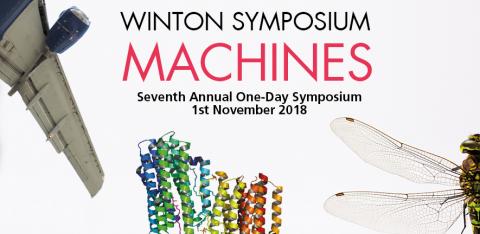
The seventh annual Winton Symposium was held on November 1, 2018 at the Cavendish Laboratory on the theme of “Machines: from cosmic to the nanoscale"
Machines for energy conversion and detectors play a crucial role in our society. Key technology drivers now seek to make them more efficient and to operate across different scales. The symposium discussed the chemically powered world of living systems alongside the man-made world of electrically and optically coupled devices with speakers’ topics ranging from electric motors to detectors of gravity waves, from nanoscale devices to those spanning kilometres to explore our universe.
Professor Sheila Rowan, Director, Institute for Gravitational Research, University of Glasgow, discussed the fundamental physics that can be explored with gravitational wave detectors, the engineering challenges of making these machines with extremely high precision and their applications. Gravitational waves are predicted by general relativity resulting from mass changes that cause extremely small ripples in space and time. This provides a way of performing astronomy without imaging with the first gravitational waves observed in 2016 emitted from the collision of two black holes. The details of the observed oscillations encode information related to this event that took place 1.3 billion light years away.
Link to presentation "Gravitation wave detectors: precision measurement technologies and their applications"
Professor Mark Kasevich, discussed the atom interferometry system he has built in his group in the Physics Department at Stanford University and how this can shed light on the link between gravitation and quantum mechanics. An ensemble of Rubidium atoms is created that is cooled to pico Kelvin temperatures, the atoms are vertically launched into the system and then with light pulses individual atoms are separated. Two ensembles of atoms are thus created which are spatially separated and then are recombined. This is equivalent to the Young’s double slit experiment which was first used to explore interference with photons.
Link to presentation "Atom Interferometry for Geodesy and Fundamental Physics"
Professor Adrian Thomas from the Zoology Department at University of Oxford discussed flying and demonstrated the design concepts utilised by different birds and the trade offs between efficiency and performance. Experiments performed on airflow show that flyers produce wingtip vortices that lead to areas of down and up lift. By flying in the regions of uplift following flyers can be more energy efficient, with fliers in the ‘V’ formation being able to be 10-20% more energy efficient. This is commonly seen in the flight of birds; planes can follow this principle but it requires accurate control of flight to maintain position in the vortices. Adrian has established Animal Dynamics Limited that build on his experience with understanding how birds fly to produce high performance drones.
Professor Barrie Mecrow from Newcastle University discussed the limits of performance of current machines and what can we do to push these boundaries. Motors are integral to our energy system with the vast majority of electricity generated using electric machines and more than half of this going to drive electrical motors. He explained how to generate more power and energy density there has been a drive to higher operating speeds and use of permanent magnets and superconductors.
Professor Mark Allen from University of Pennsylvania discussed the Micro-electro-mechanical systems (MEMs) technology and their applications. MEMs make use of micro fabrication technologies to make mechanical structures and transducers that are already used in a host of applications from microphones in mobile phones to accelerometers to pressure and chemical sensors. Mark discussed the move towards using MEMs for medical applications, where as people live longer the focus is on improving the quality of life. He described a number of medical applications where treatment can be greatly augmented by information from implantable devices that will be widely adopted.
Link to presentation "Implantable Biomedical Microelectromechanical Systems"
Professor Carlos Bustamante is Professor of Chemistry, Molecular and Cell Biology, and Physics at University of California, Berkeley. His talk explored molecular machines, which operate at energies of the order of kT and are on the nm scale. Cells are neither isotropic nor homogenous and require active motion to function, and not by diffusion alone. These have tiny machine-like devices that convert chemical energy into force or torque perform motion. He concluded that we are now able to analyse in detail how molecular motors operate, and learn from how they have evolved with the aim of imitating these in the laboratory.
Link to presentation "Power at the Nanoscale: Speed, Strength and Efficiency in Biological Motors"

